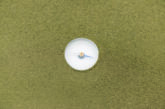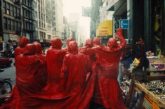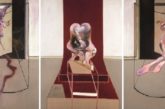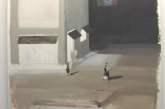La casa di biscotti (dall’8 maggio al 15 settembre 2013, Fondazione Sandretto Re Rebaudengo, Torino) è la prima personale in Italia per Riikka Kuoppala (1980), giovane filmmaker e artista “attivista” dalla Finlandia. La mostra riunisce due videoinstallazioni: la prima è stata presentata l’anno scorso alla Kluuvi Gallery di Helsinki e s’intitola Couch, TV and VCR (2012)1; l’altra, Under a Burning City (2010), è il lavoro che finora le ha meritato i maggiori consensi da parte della critica, facendola entrare nel 2011 nella decina di finalisti della Spring Exhibition, l’annuale mostra-premio internazionale della Charlottenborg Fonden di Copenaghen.
Nei due cortometraggi l’artista affronta un soggetto non facile da mettere in immagini (e che è il leitmotiv della sua produzione video) e cioè lo scarto che corre tra il vivere un evento traumatico e il raccontare quell’evento a qualcuno che non ne ha avuta esperienza diretta – così come la fatica di quel qualcuno nell’ascoltare.
Couch, TV and VCR è proiettato su un piccolo televisore dentro un curioso bugigattolo fatto di scatole di cartone. A provarsi nel racconto è una ragazzina che narra del suo rapporto conflittuale con la Custode della Chiave (probabilmente la madre, nei sottotitoli con le iniziali maiuscole come i soprannomi dei cattivi nelle fiabe). Lo scontro si consuma fuori e dentro il soggiorno di casa: là, c’è un divano rosso dove si deve star seduti composti, le gambe dritte e i piedi a terra; una TV e un videoregistratore, comprati coi suoi soldi, che però non può usare; e se è in casa da sola, la stanza rimane serrata. Ma lei ha trovato un’altra chiave e quando la Custode è fuori, il soggiorno diventa suo e là può fare tutto ciò che vuole con chi vuole, bere vino, rimpinzarsi di patatine, baciare, palpare, leccare. Intanto scorrono le immagini: la ragazzina che origlia alla porta, da cui provengono gemiti ovattati; la Custode, nuda sul water, che estrae una chiave dalla bocca e ci fissa con sguardo torvo mentre si pulisce dopo aver urinato; due corpi avviluppati. La casa, luogo sicuro e familiare, diventa qui un ambiente soffocante e pericoloso, come spesso è nelle fiabe del folklore – e qui sta il motivo del titolo della mostra. Ecco: lo stratagemma dello stanzino di cartone copia quello messo in atto dalla strega cannibale con la casetta di marzapane, bellissima a vedersi e buonissima da mangiare, ma una trappola per i poveri Hänsel e Gretel – anche loro abbandonati dai genitori. (…)
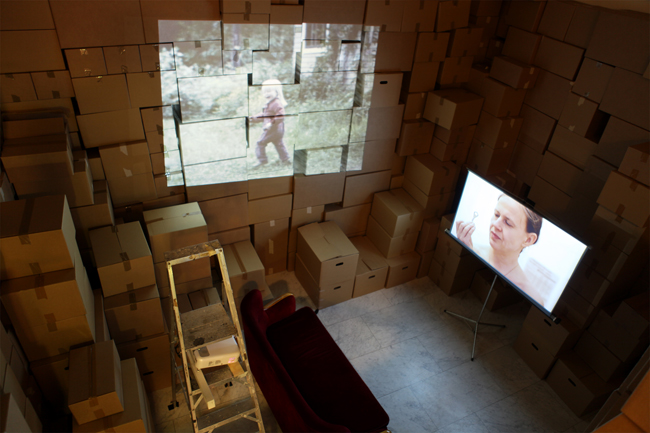
The Gingerbread House (exhibited from the 8th of May until the 15 of September 2013 at the Fondazione Sandretto Re Rebaudengo in Turin, Italy) is the first personal exhibition in Italy for the young Finnish filmmaker and “activist”, Riikka Kuoppala (1980). The exhibition encompasses two video installations: the first, entitled Couch, TV and VCR premiered in 2012 at the Kluuvi Gallery in Helsinki; the other, Under a Burning City (2010), has won extensive critical acclaim, and was shortlisted for the 2011 Spring Exhibition, a yearly award ceremony and exhibition hosted by Charlottenborg Fonden in Copenhagen. In these two short films, the artist addresses a subject matter that is not easy to portray though images: the breach that runs between experiencing a traumatic event and retelling the events to someone who was not directly involved or present and the latter’s difficulty to listen. Couch, TV and VCR is shown on a small television inside a curious closet made from cardboard boxes. The protagonist is a teenage girl who narrates her dysfunctional relationship with the Keeper of the Key (probably the mother, in the subtitles the initials of her title are capitalised, much like the nicknames of baddies in fables). The conflict takes place both inside and outside of the living room: there is a red sofa, but you must be sat upright, with straight legs and feet on the floor; there is also a TV and a tape player (both bought with the girl’s money) that she is not permitted to use; and if she is ever home alone, the room is left locked. However, she has found another key and, when the Keeper goes out, the living room is hers once more. She can do whatever she pleases with whoever she pleases: drink wine, gorge on crisps, kiss, feel and lick. Meanwhile a stream of images flows: the girl that eavesdrops at the door, behind which muffled groans can be heard; the Keeper, naked on the toilet, who extracts a key from her mouth and stares grimly at us as she cleans herself after urinating; two entangled bodies. The home, traditionally a safe and familiar place, becomes a suffocating and dangerous environment, much like it does in folklore fables: hence the exhibition’s title. The cardboard-closet device is, in fact, a reproduction of the Gingerbread House used by the cannibal witch: beautiful to behold and heavenly to eat, but in reality a devious trap for the hapless Hänsel and Gretel (who, like the girl, were also abandoned by their parents).
Stefano Ferrari
D’ARS year 53/nr 215/autumn 2013 (abstract dell’articolo)

